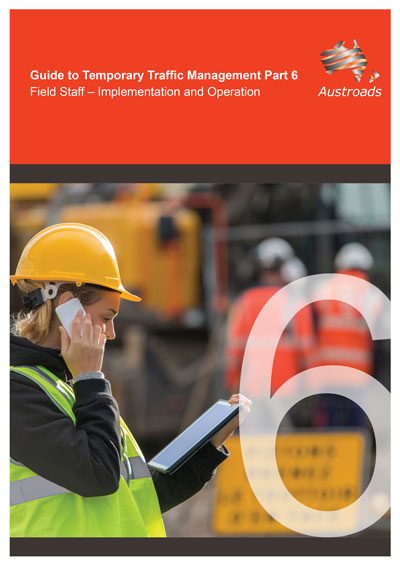Temporary Traffic Management

Guide to Temporary Traffic Management Part 6: Field Staff – Implementation and Operation
- Publication no: AGTTM06-21
- ISBN: 978-1-922382-96-2
- Published: 13 September 2021
- Edition: 1.1
- PDF (free) Download
Guide to Temporary Traffic Management Part 6: Field Staff – Implementation and Operation sets out the requirements of field staff in the process of installing, monitoring and dismantling traffic management on public roads.
View the video below for an overview of Part 6.
Edition 1.1 contains additional information regarding condition of devices and when they should be replaced, monitor and review of a Traffic Guidance Scheme, principles for removing signs and correction to errors in some diagrams and figures.
- 1. Introduction
- 1.1 Purpose
- 1.2 Structure of AGTTM
- 1.3 Scope of Part 6
- 1.4 Field Work for Office-based Staff
- 1.5 Application of Part 6 to New Zealand
- 1.6 Acronyms
- 1.7 Definitions
- 2. TTM Principles and Road Categories
- 2.1 TTM Principles
- 2.1.1 Fundamentals
- 2.1.2 Basic principles
- 2.2 Traffic Management Implementer
- 2.3 Road Categorisation
- 2.1 TTM Principles
- 3. Roles and Responsibilities
- 3.1 TTM Roles
- 3.1.1 Other TTM workers
- 3.2 Example – Career Path Progression
- 3.3 TTM Relationships
- 3.3.1 Principal Contractor – TTM responsibilities
- 3.3.2 TMD
- 3.3.3 TMI responsibilities for TTM on a worksite include:
- 3.3.4 Interactions between the Principal Contractor and the TMI
- 3.3.5 TMI - TC/Other TTM worker interactions
- 3.3.6 Traffic Controller (TC)
- 3.3.7 Other TTM workers
- 3.1 TTM Roles
- 4. Pre-Shift Activities
- 4.1 General
- 4.2 Vehicle Checks
- 4.3 Job Pack Check
- 4.4 Equipment and Devices
- 4.5 Condition of Devices
- 4.6 Resources
- 5. Pre-start
- 5.1 General
- 5.1.1 Identify hazards
- 5.1.2 Assess the risk
- 5.1.3 Implement controls
- 5.1.4 Monitor and review
- 5.2 TMP and TGS Development - Residual Risk Register
- 5.3 On Site Safety Analysis and Risk Assessment
- 5.4 Toolbox Talks
- 5.4.1 TTM staff
- 5.4.2 Construction workers/visitors
- 5.1 General
- 6. TGS Installation
- 6.1 General
- 6.2 Typical Installation Principles
- 6.3 Installation Process
- 6.4 Placement of Signs and Devices
- 6.4.1 Two-way road - lane closure
- 6.4.2 Two-way road (lateral shift)
- 6.4.3 Two-way road - lane closure with side roads
- 6.4.4 Multi-lane un-divided road - lane closure
- 6.4.5 Multi-lane divided road - left or right lane closure
- 6.5 Positioning of Signs and Devices
- 6.6 Typical Locations for Signs
- 6.6.1 Long term
- 6.6.2 Short term
- 6.7 Orientation of Signs and Devices
- 6.8 Tolerances
- 6.9 ITS Devices
- 7. TGS Operations and Maintenance
- 7.1 General
- 7.2 Before Work Starts
- 7.3 During the Hours of Work
- 7.4 Aftercare - Worksite Arrangements Outside Working Hours
- 7.5 Record Keeping
- 7.6 Incidents
- 7.7 TMI Monitoring
- 7.8 Monitor and Measure TTM
- 7.9 Excessive or Inappropriate Use of Temporary Speed Limits
- 7.10 Excessive Signage
- 8. TGS Removal
- 8.1 General
- 8.2 Typical Removal Principles
- 8.3 Removal Process
- 8.4 Removal Order for Signs and Devices
- 8.4.1 Two-way road – lane closure
- 8.4.2 Two-way road – lateral shift
- 8.4.3 Two-way road – lane closure with side road intersections
- 8.4.4 Multi-lane un-divided road – lane closure
- 8.4.5 Multi-lane divided road – left or right lane closure
- 9. Low Light Works
- 9.1 Activity During Low Light
- 9.2 Artificial Lighting
- 10. Unattended Sites
- Appendix A Sample TTM Career Path Stages
- Appendix B Sample Risk Assessment Form
- Appendix C Sample Toolbox Talk
- Appendix D Sample Daily Traffic Management Diary
Related publications
Latest Temporary Traffic Management News
